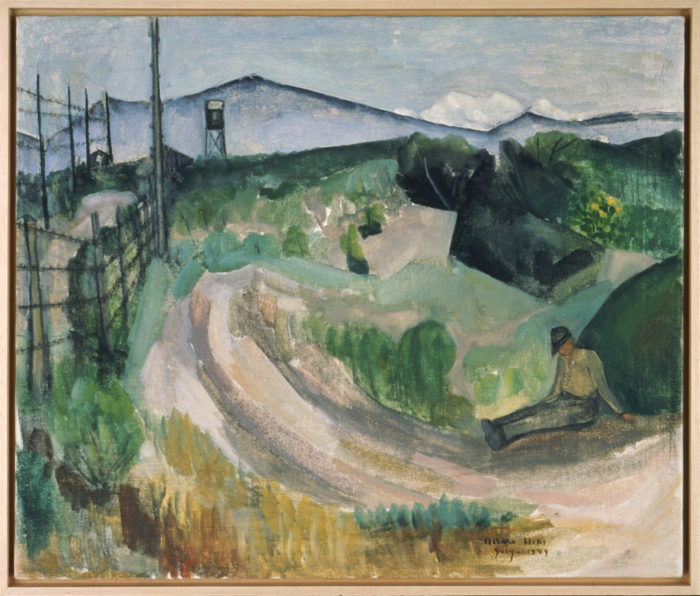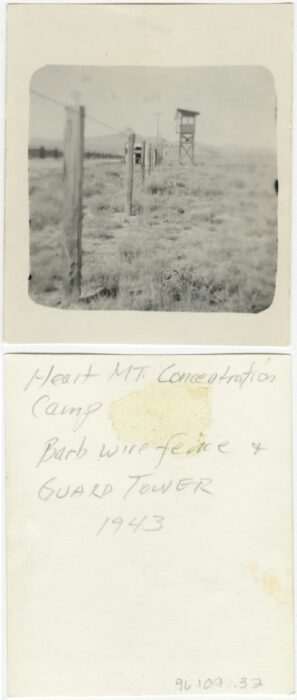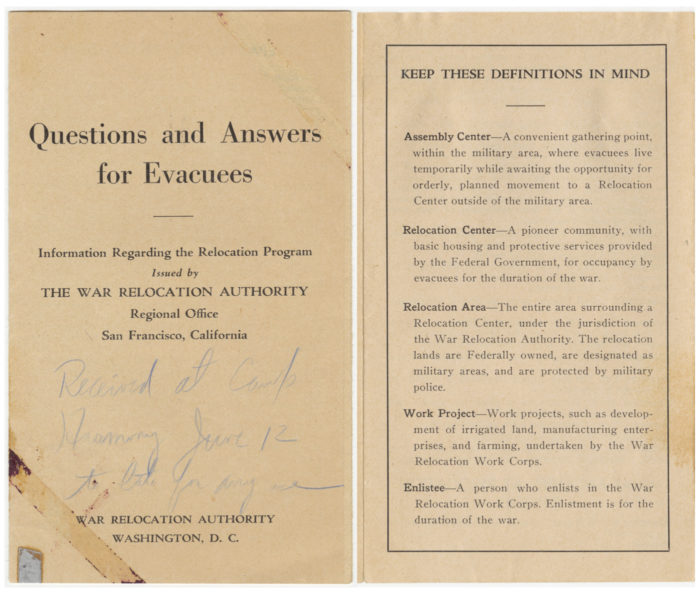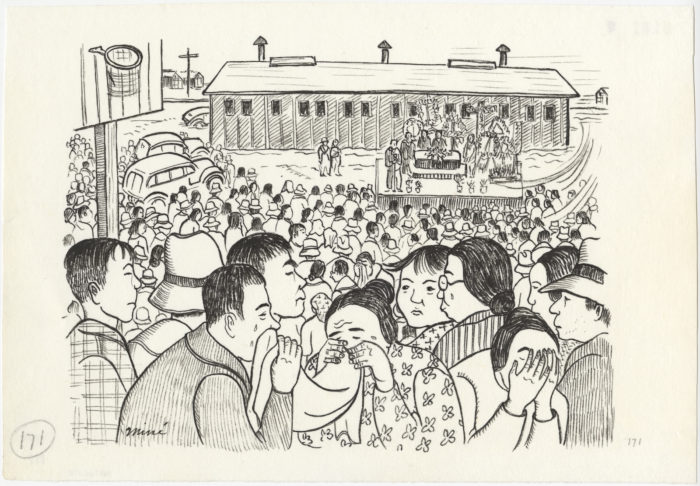Topaz
Location: Delta, Utah
Peak population: 8,130
Date opened: September 11, 1942
Date closed: October 31, 1945
Most of those held in Topaz were from the San Francisco Bay area: Alameda, San Francisco, and San Mateo Counties in California.
Located at 4,600 feet of elevation in Millard County, in west-central Utah, Topaz was 16 miles northwest of the town of Delta and 125 miles southwest of Salt Lake City. It occupied 19,800 acres of extremely flat terrain in the Sevier Desert, where temperatures ranged from 106 degrees in summer to below zero in winter. Dust was a major problem.
The Topaz War Relocation Center held many urban Japanese Americans from the San Francisco Bay area, such as Miné Okubo, the author of Citizen 13660. Topaz is known for the art and literature that incarcerees created there.
For more info about Topaz, click here.
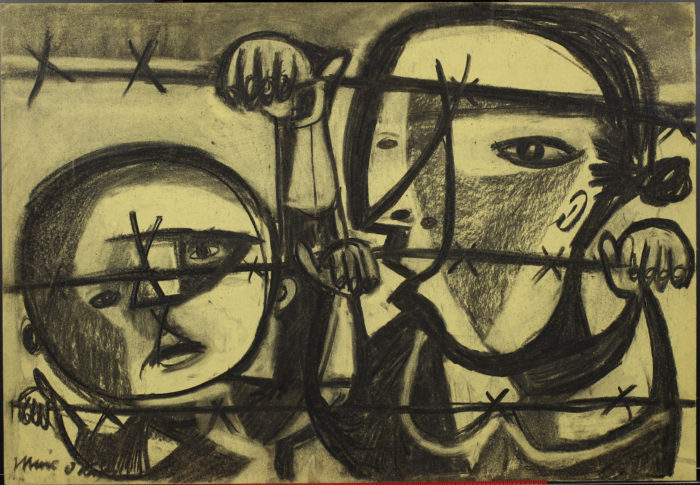
Miné Okubo, Untitled, n.d., charcoal on paper. Japanese American National Museum, Gift of Miné Okubo Estate (2007.62.5)
Click to open full-size image in new tab.This object is part of the story Sketches from Within, which is about Justice & Democracy.
- What do you see depicted in this charcoal drawing by Miné Okubo?
- Based on body language and facial expressions, what can you infer about these figures?
- What emotions are evoked by this drawing?
Miné Okubo is a Japanese American artist best known for her black and white ink drawings, though this sketch is done in charcoal. As you view more of her works on this website, consider how her artistic tools change the mood of her drawings and why she may have chosen to do this particular scene in charcoal rather than ink.
- How is this sketch different from or similar to the rest of her work?
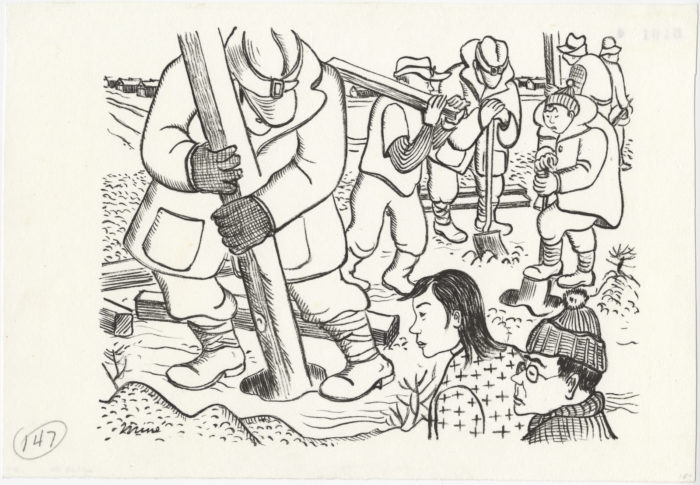
Miné Okubo, Untitled (Fence and watchtower construction, Central Utah Relocation Project, Topaz, Utah, 1942–1944), n.d., ink on paper. Japanese American National Museum, Gift of the Miné Okubo Estate (2007.62.154)
Click to open full-size image in new tab.This object is part of the story Sketches from Within, which is about Justice & Democracy.
This is a drawing of the Topaz concentration camp by Miné Okubo. She documented her personal story as a Topaz inmate in great detail through her drawings and paintings. Many of her drawings were published in an autobiographical book titled Citizen 13660. In this book, Okubo provided descriptions to accompany each image. Here’s what she wrote about this image:
Fence posts and watch towers were now constructed around the camp by the evacuees to fence themselves in.
- What thoughts do you have as you read this description?
- What questions do you have?
- How does this image heighten the sense of injustice in incarcerating people without cause?
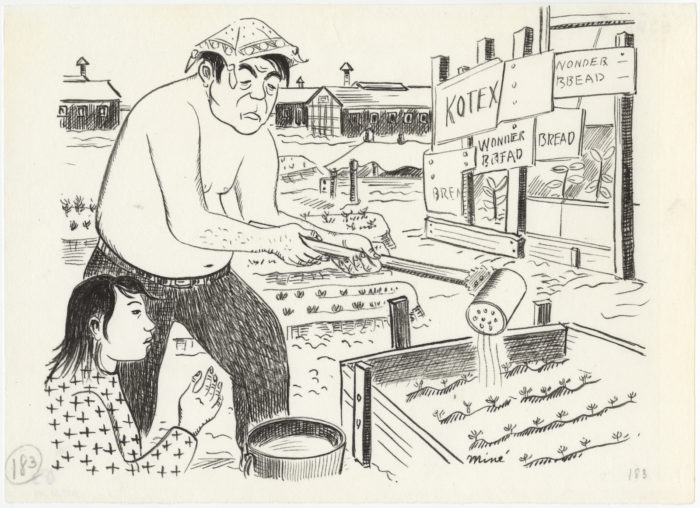
Miné Okubo, Untitled (Victory gardens, Central Utah Relocation Project, Topaz, Utah, 1942–1944), n.d., ink on paper. Japanese American National Museum, Gift of the Miné Okubo Estate (2000.62.190)
Click to open full-size image in new tab.This object is part of the story Sketches from Within, which is about Justice & Democracy.
This is another drawing by Miné Okubo that depicts life at Topaz.
- What do you think the individuals in this drawing are doing?
- Where are they?
- Can you tell what the climate there is like by looking at this drawing?
In Citizen 13660 Okubo wrote the following about this image:
Despite reports that the alkaline soil was not good for agricultural purposes, in the spring practically everyone set up a victory garden. Some of the gardens were organized, but most of them were set up anywhere and any way. Makeshift screens were fashioned out of precious cardboard boxes, cartons, and scraps of lumber to protect the plants from the whipping dust storms.
Victory gardens were planted during wartime to help prevent a food shortage by reducing the demands on the country’s food supply. Eating homegrown produce was also important because the trains and trucks were needed to transport soldiers and weapons for the war. To eat food grown in your garden was a display of patriotism and a way for people to contribute to the war effort. First Lady Eleanor Roosevelt was a big supporter of victory gardens and planted one at the White House.
It is interesting to consider that Japanese Americans incarcerated in camps participated in such a patriotic act during a time when they were not being treated fairly as Americans.

Miné Okubo, Untitled (Boarding the bus to leave camp, Central Utah Relocation Project, Topaz, Utah, 1942–1944), n.d., ink on paper. Japanese American National Museum, Gift of the Miné Okubo Estate (2007.62.205)
Click to open full-size image in new tab.This object is part of the story Sketches from Within, which is about Justice & Democracy.
The last image in Okubo’s Citizen 13660 book is this one.
- How would you describe what is depicted in this drawing?
- What evidence do you see to support your description?
- The woman in the foreground is the artist, Miné Okubo. How would you describe her facial expression?
- What thoughts might be going through her mind at this moment?
This is what Okubo wrote about this image:
I looked at the crowd at the gate. Only the very old or very young were left. Here I was, alone, with no family responsibilities, and yet fear had chained me to the camp. I thought, “My God! How do they expect those poor people to leave the one place they can call home?” I swallowed a lump in my throat as I waved good-by to them. I entered the bus. As soon as all the passengers had been accounted for, we were on our way. I relived momentarily the sorrows and the joys of my whole evacuation experience, until the barracks faded away into the distance. There was only the desert now. My thoughts shifted from the past to the future.
Japanese American National Museum, Gift of Dave Tatsuno in memory of Walter Honderick (91.74.1–8)
Click to open full-size image in new tab.This object is part of the story Silent Skater, which is about Dignity.
Watch this short video clip.
- What is she doing?
- Where do you think she might be? Why do you think that?
- How might you describe her mood?
- Who do you think recorded this video?
- What else do you observe?
Japanese American National Museum, Gift of Dave Tatsuno in memory of Walter Honderick (91.74.1–8)
Click to open full-size image in new tab.This object is part of the story Silent Skater, which is about Dignity.
Watch this short video clip from the Topaz War Relocation Center.
- How is the environment similar to or different from where you live?
The Topaz War Relocation Center was located in Millard County in West Central Utah, 16 miles northwest of the town of Delta and 125 miles southwest of Salt Lake City. Situated at 4,600 feet of elevation, the camp occupied 19,800 acres of extremely flat terrain in the Sevier Desert. Dust was a major problem, as were extreme temperatures that ranged from 106 degrees in summer to below zero in winter.
Japanese American National Museum, Gift of Dave Tatsuno in memory of Walter Honderick (91.74.1–8)
Click to open full-size image in new tab.This object is part of the story Silent Skater, which is about Dignity.
Watch this video and think about what it might have been like to live in this community.
At its peak, Topaz housed 8,130 Japanese Americans. Most of those held in Topaz were from the San Francisco Bay area in California: Alameda, San Francisco, and San Mateo Counties.
Each residential block had twelve housing barracks, a dining hall, a bathroom, a laundry facility, a recreation hall, and a block manager’s office. Each block also had a community mess hall, where almost everyone ate their meals. Some inmates were able to get jobs as cooks, dishwashers, or other staff positions within the camps, but many did not work. For the Issei, who often worked six or seven days a week, this was the most free time they ever had since immigrating to the United States. The inmates kept themselves busy taking classes like English and citizenship, or working on gardens; many did arts and crafts to pass the time. If they wanted to buy things they couldn’t get at the camps, they ordered them from catalogs for Sears or Montgomery Ward. At Topaz, some ordered ice skates by mail to use at the camp rink.
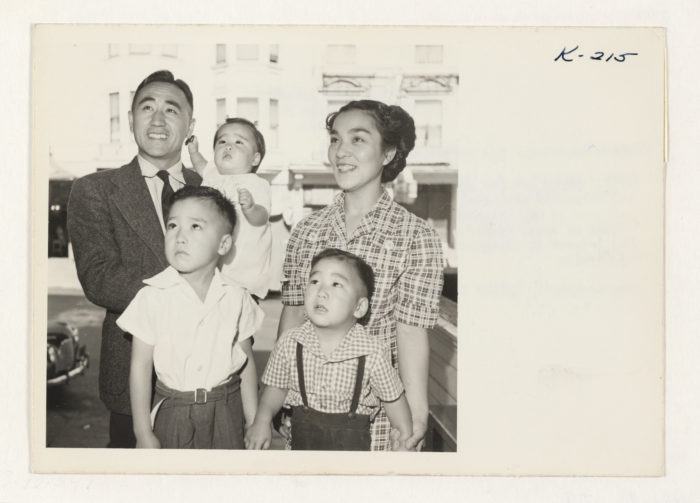
“War Relocation Authority Photographs of Japanese-American Evacuation and Resettlement Series 16: Resettlement” (Volume 81, Section K, WRA no. 215), courtesy of The Bancroft Library, University of California, Berkeley
Click to open full-size image in new tab.This object is part of the story Silent Skater, which is about Dignity.
The person who took these home movies was Dave Tatsuno (1913–2006). Mr. Tatsuno was well known within the Bay Area’s Japanese American community for operating the Nichi Bei Bussan stores in San Jose and San Francisco, California. The Tatsuno home movie collection documents activities in Topaz concentration camp as well as pre-WWII festivals, sporting events, family outings, holidays, celebrations, and the Tatsuno family business, the Nichi Bei Bussan.
In 1942, Mr. Tatsuno and his family were incarcerated at the Topaz War Relocation Center in the Utah desert. Over the next three years, shooting covertly with a contraband camera, he recorded everyday life in the dust-blown barracks community that at its height was home to more than 8,000 Americans of Japanese descent. Mr. Tatsuno’s haunting footage was later compiled into a 48-minute silent film, Topaz. In 1996, Topaz was placed on the National Film Registry of the Library of Congress. Mr. Tatsuno’s film was only the second home movie to be included in the registry, which is primarily dedicated to Hollywood classics like Citizen Kane and Casablanca. The first home movie to be included in the registry was Abraham Zapruder’s film of President John F. Kennedy’s 1963 assassination.

